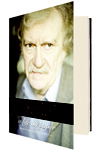Although nearly invisibile to English readers, Georges-Olivier Châteaureynaud is a prolific, highly decorated author. He branches from that tree of fabulists who take inspiration from myth and pre-science, and, like any French writer worth his salt, belongs to a literary movement: La Nouvelle Fiction, whose explicit intention is to rehabilitate the imaginary. Despite the fact that translator Edward Gauvin has selected work from across the thirty years of Châteaureynaud’s career, this collection shows remarkable coherence. Characters struggle preternaturally with the singularity of their existence and ephemerality. Stones, statues, photographs, museums, and the act of writing itself appear as imperfect attempts at preservation, while the familiar forces of death and loss—fire and decay, time and forgetfulness—appear as themselves, alongside several physical abysses. The reader, encountering several of the same characters or locations in different stories, has the impression that Châteaureynaud’s imaginary spaces are really a single space, a melancholy Winesburg, Ohio, repopulated by denizens of the Twilight Zone.
A Life on Paper offers twenty-three domestic fantasies that describe reality with an asterisk. Châteaureynaud introduces mythological characters or creatures into contemporary settings, as when extreme tourists venture risky visits to the Sirens. Or else he removes one or two barriers to the impossible, so that a mummy with exquisitely lifelike glass eyes can persist as a half-animate curio, or a writer can unexpectedly stumble onto a museum dedicated to his own life (including his future). When Châteaureynaud dispenses with the veneer of contemporaneity, he reveals how deeply his roots delve into the tradition of the fairy tale: “The Pavilion and the Linden” resembles nothing so much as Borges’s “On Exactitude in Science,” while “The Beautiful Coalwoman” reads like R-rated H. C. Andersen.
Naturally, some stories—“Delaunay the Broker,” “Come Out, Come Out,” and the title story—are more memorable than others. These do not traffic in the chill of horror or the allegory of science fiction, but take their unsettling power from their ability to soothe the freakish into the quotidian. Even when unreality persists, everything ends with a sense of inevitability, by returning to whatever passes for normalcy, as though to show that the indelible mark of even the most fantastic event cannot retain its power. At the end of “The Only Mortal,” a soldier upon whom the word mortal has mysteriously appeared resigns himself to its presence on his chest, where “it flickered with the passing days—regularly and peacefully, on the whole—the pilot...
You have reached your article limit
Sign up for a digital subscription and continue reading all new issues, plus our entire archives, for just $1.50/month.
Already a subscriber? Sign in





